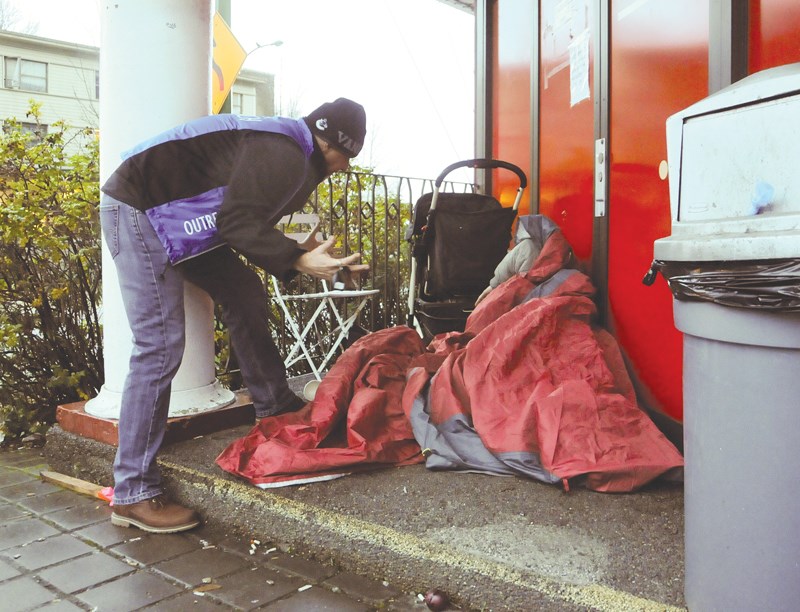Homelessness appears to be on the decline on the North Shore, despite a spike in the Lower Mainland.
Metro Vancouver released the preliminary data from the 2017 homeless count Monday, which found 100 people living homeless in North Vancouver and West Vancouver, down 17 per cent from the last count in 2014. Across the region, homelessness is up by 30 per cent with 3,605 people counted on March 8.
Every three years, volunteers fan out around the Lower Mainland for a 24-hour period to survey the homeless population, looking for demographic info and trends that can help policy-makers respond to the homelessness crisis.
The local homeless population peaked in 2008 with 127 and has been declining ever since, accord to Monday’s preliminary report, although housing advocates always warn that the homeless count is typically far lower than reality.
Of 100 homeless on the North Shore, 11 were “unsheltered,” meaning they were found in alleys, doorways, parkades, parks or vehicles. That’s a significant drop from 2014 when 60 people were “sleeping rough.”
“Although the overall count was down, and although there was only a very small number who were actually outside, what we did have was a lot more people who were actually accessing services in the shelters,” said Ken Falconer, manager of special projects for the Lookout Emergency Aid Society, which runs the North Shore Shelter on West Second Street.
The particularly miserable winter was certainly a factor, driving homeless folks into shelters or to call in favours from friends or family in hopes of getting out of the cold and wet.
The North Shore emergency weather shelter, which opens only during extreme cold or extended periods of rain or snow, had 86 operating days over the winter period, double what it had the previous year. During those 86 nights, they had 1,238 guests spending the night, compared to 493 in 2015-2016.
Also since the last count, Lookout’s Dovercourt Residence, a “sober living house” for men, opened in Lynn Valley, getting more people into permanent housing, Falconer said.
In any case, the official numbers are most assuredly an underestimate, Falconer said, as many people evade the count or decline to take the survey often because they’re in denial about being homeless.
“In their own mind, they still believe this is a temporary situation and they don’t consider themselves homeless. All of these people are very proud people who haven’t been homeless,” he said.
“They’re in their senior years and all of a sudden they’re finding themselves in a situation where they just never imagined this could happen to them. I think that’s one of the challenging things.
Homelessness can happen to just about anyone.”
The North Shore was the only region of the Lower Mainland that showed a decline. That may have something to do with the cost of housing here driving away people, Falconer said.
“The areas where it’s more affordable to live are seeing the highest increase in the homeless count and I think that’s because people are going there filled with hope they’re going to find something that they can afford and then it’s not there for them,” he said.
The key to solving the crisis, Faloncer said, is for governments to fund the creation of affordable housing units capped at $375 per month – the maximum the province funds for people on social assistance.
“While there is new affordable housing units coming online, there is not enough new affordable housing units coming online and we still have 100 people on the North Shore,” he said.



